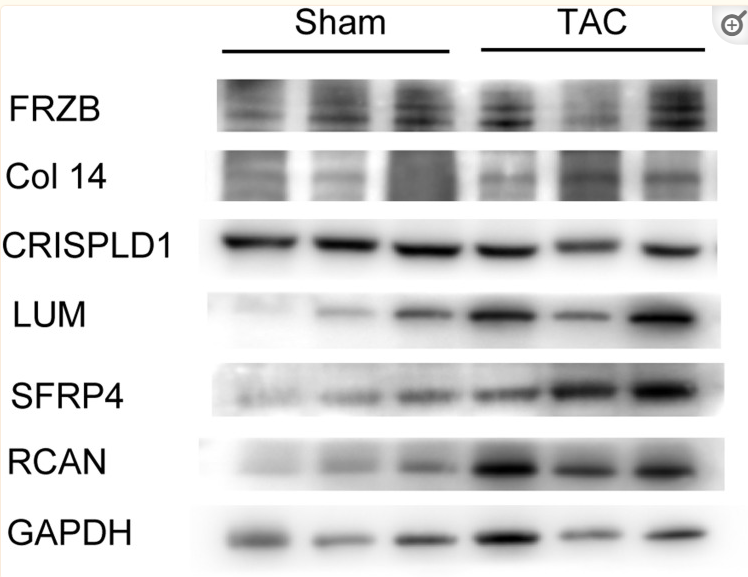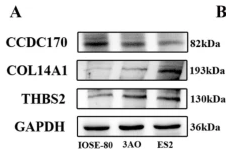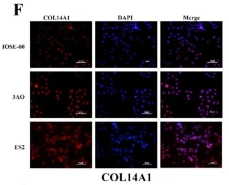Collagen XIV alpha 1 Antibody - #AF0573
| Product: | Collagen XIV alpha 1 Antibody |
| Catalog: | AF0573 |
| Description: | Rabbit polyclonal antibody to Collagen XIV alpha 1 |
| Application: | WB IHC IF/ICC |
| Cited expt.: | WB, IF/ICC |
| Reactivity: | Human, Mouse |
| Prediction: | Bovine, Rabbit, Dog, Xenopus |
| Mol.Wt.: | 193kDa; 194kD(Calculated). |
| Uniprot: | Q05707 |
| RRID: | AB_2834370 |
Related Downloads
Protocols
Product Info
*The optimal dilutions should be determined by the end user. For optimal experimental results, antibody reuse is not recommended.
*Tips:
WB: For western blot detection of denatured protein samples. IHC: For immunohistochemical detection of paraffin sections (IHC-p) or frozen sections (IHC-f) of tissue samples. IF/ICC: For immunofluorescence detection of cell samples. ELISA(peptide): For ELISA detection of antigenic peptide.
Cite Format: Affinity Biosciences Cat# AF0573, RRID:AB_2834370.
Fold/Unfold
Collagen alpha 1(XIV) chain; Collagen type XIV alpha 1 (undulin); Collagen type XIV alpha 1; UND; Undulin (fibronectin tenascin related); Undulin; COL14A1;
Immunogens
A synthesized peptide derived from human Collagen XIV alpha 1, corresponding to a region within C-terminal amino acids.
- Q05707 COEA1_HUMAN:
- Protein BLAST With
- NCBI/
- ExPASy/
- Uniprot
MKIFQRKMRYWLLPPFLAIVYFCTIVQGQVAPPTRLRYNVISHDSIQISWKAPRGKFGGYKLLVTPTSGGKTNQLNLQNTATKAIIQGLMPDQNYTVQIIAYNKDKESKPAQGQFRIKDLEKRKDPKPRVKVVDRGNGSRPSSPEEVKFVCQTPAIADIVILVDGSWSIGRFNFRLVRHFLENLVTAFDVGSEKTRIGLAQYSGDPRIEWHLNAFSTKDEVIEAVRNLPYKGGNTLTGLALNYIFENSFKPEAGSRTGVSKIGILITDGKSQDDIIPPSRNLRESGVELFAIGVKNADVNELQEIASEPDSTHVYNVAEFDLMHTVVESLTRTLCSRVEEQDREIKASAHAITGPPTELITSEVTARSFMVNWTHAPGNVEKYRVVYYPTRGGKPDEVVVDGTVSSTVLKNLMSLTEYQIAVFAIYAHTASEGLRGTETTLALPMASDLLLYDVTENSMRVKWDAVPGASGYLILYAPLTEGLAGDEKEMKIGETHTDIELSGLLPNTEYTVTVYAMFGEEASDPVTGQETTLALSPPRNLRISNVGSNSARLTWDPTSRQINGYRIVYNNADGTEINEVEVDPITTFPLKGLTPLTEYTIAIFSIYDEGQSEPLTGVFTTEEVPAQQYLEIDEVTTDSFRVTWHPLSADEGLHKLMWIPVYGGKTEEVVLKEEQDSHVIEGLEPGTEYEVSLLAVLDDGSESEVVTAVGTTLDSFWTEPATTIVPTTSVTSVFQTGIRNLVVGDETTSSLRVKWDISDSDVQQFRVTYMTAQGDPEEEVIGTVMVPGSQNNLLLKPLLPDTEYKVTVTPIYTDGEGVSVSAPGKTLPSSGPQNLRVSEEWYNRLRITWDPPSSPVKGYRIVYKPVSVPGPTLETFVGADINTILITNLLSGMDYNVKIFASQASGFSDALTGMVKTLFLGVTNLQAKHVEMTSLCAHWQVHRHATAYRVVIESLQDRQKQESTVGGGTTRHCFYGLQPDSEYKISVYTKLQEIEGPSVSIMEKTQSLPTRPPTFPPTIPPAKEVCKAAKADLVFMVDGSWSIGDENFNKIISFLYSTVGALNKIGTDGTQVAMVQFTDDPRTEFKLNAYKTKETLLDAIKHISYKGGNTKTGKAIKYVRDTLFTAESGTRRGIPKVIVVITDGRSQDDVNKISREMQLDGYSIFAIGVADADYSELVSIGSKPSARHVFFVDDFDAFKKIEDELITFVCETASATCPVVHKDGIDLAGFKMMEMFGLVEKDFSSVEGVSMEPGTFNVFPCYQLHKDALVSQPTRYLHPEGLPSDYTISFLFRILPDTPQEPFALWEILNKNSDPLVGVILDNGGKTLTYFNYDQSGDFQTVTFEGPEIRKIFYGSFHKLHIVVSETLVKVVIDCKQVGEKAMNASANITSDGVEVLGKMVRSRGPGGNSAPFQLQMFDIVCSTSWANTDKCCELPGLRDDESCPDLPHSCSCSETNEVALGPAGPPGGPGLRGPKGQQGEPGPKGPDGPRGEIGLPGPQGPPGPQGPSGLSIQGMPGMPGEKGEKGDTGLPGPQGIPGGVGSPGRDGSPGQRGLPGKDGSSGPPGPPGPIGIPGTPGVPGITGSMGPQGALGPPGVPGAKGERGERGDLQSQAMVRSVARQVCEQLIQSHMARYTAILNQIPSHSSSIRTVQGPPGEPGRPGSPGAPGEQGPPGTPGFPGNAGVPGTPGERGLTGIKGEKGNPGVGTQGPRGPPGPAGPSGESRPGSPGPPGSPGPRGPPGHLGVPGPQGPSGQPGYCDPSSCSAYGVRAPHPDQPEFTPVQDELEAMELWGPGV
Predictions
Score>80(red) has high confidence and is suggested to be used for WB detection. *The prediction model is mainly based on the alignment of immunogen sequences, the results are for reference only, not as the basis of quality assurance.
High(score>80) Medium(80>score>50) Low(score<50) No confidence
Research Backgrounds
Plays an adhesive role by integrating collagen bundles. It is probably associated with the surface of interstitial collagen fibrils via COL1. The COL2 domain may then serve as a rigid arm which sticks out from the fibril and protrudes the large N-terminal globular domain into the extracellular space, where it might interact with other matrix molecules or cell surface receptors (By similarity).
Lysines at the third position of the tripeptide repeating unit (G-X-Y) are hydroxylated in all cases and bind carbohydrates.
Prolines at the third position of the tripeptide repeating unit (G-X-Y) are hydroxylated in some or all of the chains.
May contain numerous cysteine residues involved in inter- and intramolecular disulfide bonding.
Secreted>Extracellular space>Extracellular matrix.
Belongs to the fibril-associated collagens with interrupted helices (FACIT) family.
Research Fields
· Organismal Systems > Digestive system > Protein digestion and absorption.
References
Application: WB Species: Human Sample:
Application: IF/ICC Species: Human Sample:
Application: WB Species: Mouse Sample: myocardium
Restrictive clause
Affinity Biosciences tests all products strictly. Citations are provided as a resource for additional applications that have not been validated by Affinity Biosciences. Please choose the appropriate format for each application and consult Materials and Methods sections for additional details about the use of any product in these publications.
For Research Use Only.
Not for use in diagnostic or therapeutic procedures. Not for resale. Not for distribution without written consent. Affinity Biosciences will not be held responsible for patent infringement or other violations that may occur with the use of our products. Affinity Biosciences, Affinity Biosciences Logo and all other trademarks are the property of Affinity Biosciences LTD.





